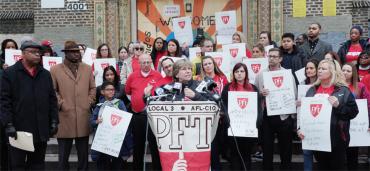Learning shouldn’t be hazardous
“Every day I go to school, I feel like I’m in a prison or a junkyard,” wrote one fourth-grader. “The school is falling apart,” wrote another. “We are getting sick.” “It’s affecting our learning in a negative way.” “What if your child was in this school?” “We need help.”
The letters were written by students in a Philadelphia public school later found to have dangerously high levels of cancer-causing asbestos fibers and lead dust, which can cause permanent brain damage and behavioral problems.
Tragically, in what President Donald Trump calls the best economy ever, such conditions are common across the country. Four public schools in Scranton, Pa., were closed last month because of hazardous asbestos and lead conditions. The day juniors at a Chicago high school took the SAT, some were sweltering while others were shivering because the HVAC was broken. Fast-growing suburbs increasingly use trailers in which teachers have as many as 25 students in the space of a hotel room. And the recent earthquakes in Puerto Rico have left 20 percent of the island’s schools structurally unsound.
America’s public schools received a D+ on the American Society of Civil Engineers’ latest infrastructure report card. And it’s not just schools that are in disrepair: The country’s infrastructure—vital things like bridges, drinking water, transit and energy—earned a cumulative D+. Years of disinvestment, deferred maintenance and neglect have left even urgent repairs unmade.
No president has celebrated Infrastructure Week so many times, yet done so little to actually address the nation’s infrastructure needs, as Donald Trump. The ASCE estimates that $2 trillion in infrastructure investments are necessary over the next decade. Imagine what could have happened if Trump and his Republican allies made those investments instead of enacting their nearly $2 trillion tax cut bill. The electric grid could be secured, bridges repaired, schools modernized, broadband expanded and communities safeguarded against climate change. Instead, we’re left with a windfall for the wealthy, an enormous national deficit and children writing heartbreaking pleas for help.
Every dollar spent on infrastructure pumps up to $4 back into the economy, while a dollar spent on corporate tax cuts returns just 32 cents. The BlueGreen Alliance found that repairing America’s infrastructure could create 2.7 million good jobs across the country and increase U.S. gross domestic product by $377 billion.
But the foremost reason to address America’s infrastructure crisis is because it affects people’s lives. Think about schools, where educators’ working conditions are children’s learning conditions. The AFT fights to make schools safe and welcoming by using every tool we have—bargaining, politics and advocacy. We have even filed lawsuits demanding that officials address unsafe and unacceptable school conditions—in Philadelphia, in Detroit and, when I was president of the local teachers union there, in New York City.
Last week, while unions in Philadelphia were creating rapid response teams to address the most hazardous conditions in schools, Vice President Mike Pence and Education Secretary Betsy DeVos were visiting the city. Sadly, they were not there to help, but to promote privatization and school vouchers. Rather than destabilizing and defunding public schools, this administration should fulfill its responsibility to support them and make them safe.
House Democratic leaders recently unveiled a $760 billion, five-year infrastructure proposal. And nearly all of the Democratic presidential candidates have offered ambitious infrastructure plans. Infrastructure was once a bipartisan priority, but the only infrastructure the president and Republicans in Congress appear interested in is building a Mexican border wall.
The AFT and other unions are investing pension assets to rebuild the nation’s infrastructure. Union investments in infrastructure projects, in conjunction with the Clinton Global Initiative, top $12 billion so far and have created more than 100,000 jobs. For example, teacher retirement funds were part of the $3.6 billion overhaul of LaGuardia Airport, creating 15,000 well-paying jobs.
In McDowell County, W.Va., one of the poorest counties in America, the AFT is leading a partnership to build a teacher housing village, so we can attract and retain teachers and provide a community gathering place. Unions are supplying most of the initial funding, and the jobs being created are all good, family-supporting union jobs. Our communities are our responsibility, but we can only do so much. Just as Franklin D. Roosevelt expanded electricity across the United States, and Dwight D. Eisenhower connected our nation through the interstate highway system, extensive investments in our country’s infrastructure can only be made by government.
Imagine if this administration, instead of lavishing a $2 trillion tax cut on corporations and the wealthiest Americans, fulfilled its responsibility to provide all children, regardless of their family circumstances, with a great education in public schools that are healthy, safe and welcoming. This administration doesn’t make children a priority, so we must.

